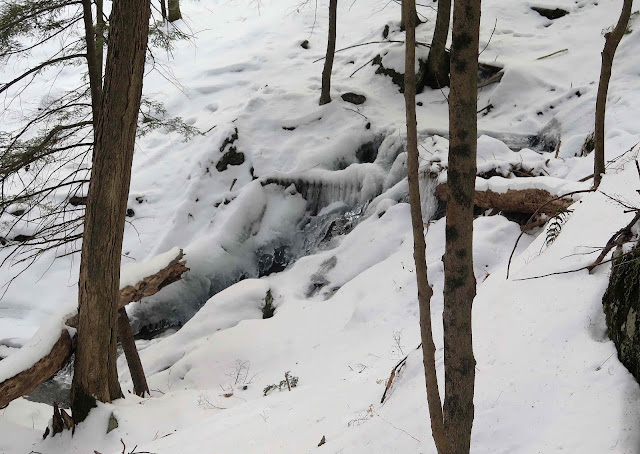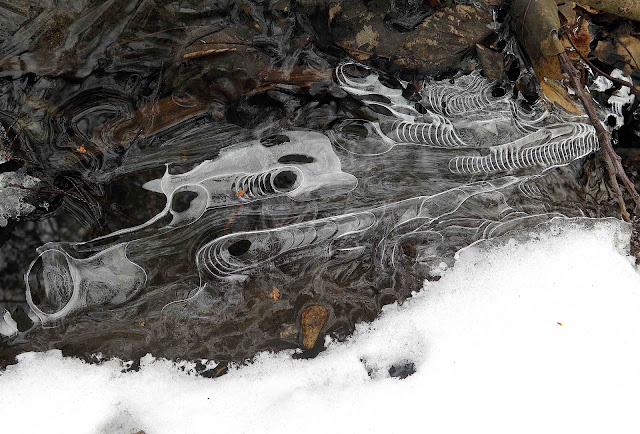I just stepped outside my door at 5pm this afternoon: it was SEVENTY DEGREES under a sunny sky and the snow was melting fast! What a change from just yesterday, when my friend Sue and I ventured high into the mountains surrounding Moreau Lake. It was warmish (for winter) but still below freezing then, and snow still lay thick on the woodland trails and atop the solidly frozen lake. We thought it might be our last chance this year to find the porcupine dens in some marble caves up on the mountain heights, as well as to check out the icy beauty along the creek that tumbles down the mountain.

The caves in which porcupines have been known to den are easy enough to find (although we have to bushwhack off official trails to do so), but whether the porkies still occupy them can only be known by observing their well-trodden trails through the snow. As we neared the caves, we promptly discovered the packed-down, dirt-stained trails so distinctive of porcupine travels. Porcupines don't wander all over the woods each day in search of food, but head straight from their dens to their chosen tree (usually a Hemlock), the same tree that they return to daily to feed on the bark.
The trails become so well-packed no individual footprints can be discerned in them, but the presence of quills and hairs (not to mention much porkie pee and poop) makes it obvious what animal has passed this way, again and again.
And sure enough, these well-trodden trails led straight to the very same caves these porcupines have occupied for years.
Not all of the caves up here would be fit for animal occupation, for some of them still shelter the running stream that was quite likely the force that eroded such caves in the marble bedrock.
I am guessing that the bedrock here is marble, for the plants that populate these rocks are definite calciphiles, requiring lime in order to thrive (and marble is metamorphosed limestone). Two examples of such calciphiles are pictured here: a clump of long-fronded Walking Fern (Asplenium rhizophyllum) that is studded with a couple of rosettes of Rose Moss (Rhodobryum ontariense).
This rock-studded stream bed flows directly out of the mouth of one cave. Sue has noticed an unusual moss that is completely submerged in the shallow water.
This moss's long floppy branches were rippling in the flowing water. The spearhead shape of the individual leaves, as well as this aquatic habitat, suggested to us that the moss might be one of the Fontanalis species, but we could not be sure. We are definitely missing our bryologist friends like Nancy Slack and Ruth Brooks, either of whom could probably have identified this moss at a glance.
As we wandered around the snow-carpeted woods, we each stopped to admire this fallen limb so beautifully embellished with thick clusters of Turkey Tail Fungus (Trametes versicolor).
We also noticed several new trails where a solitary porcupine had wandered off, quite probably in search of new trees to feed in, since most of the hemlocks surrounding the caves have been stripped of their bark and needles by many previous generations of porcupines.
We also found several trails where fishers had been cruising this territory, most likely seeking their primary prey animals, the porcupines. Fishers are known to be the porcupines' most successful predator, using their speed and agility to exhaust a porcupine until the fisher can quickly lunge in and flip the weakened creature, exposing the parts of the animal undefended by quills. We were glad we did not find any evidence of such a kill today.
We took our time descending the mountain, leaving the official trail to follow more closely the ice-embellished stream that tumbles down from the rocky heights.
We knew that rain and warmer temps were predicted for the following day, so this might possibly be our last chance this year to delight in the many beautiful ways that splashing water and freezing air produce their exquisite creations. Here are just a few of the examples we found on our descent.
Each icy creation appeared even more beautiful than the last. I'm so glad we made the most of what might be the last truly wintry day of winter. Heavy rains and much warmer air will now contribute to new forms of beauty and fascination along this stream and throughout this mountainside forest as spring approaches. I'm quite eager for that change!
















4 comments:
Loved this little peek into Porcupine Living. Since we moved into our wooded NH home just shy of 10 years ago, we've had a resident porcupine. It would sit curled in a perfect sphere in one of the hemlocks in front of our house on warmish winter days, basking in the sun, and we'd also see it ambling back and forth between that area and the woods beyond our back yard in the early morning and late afternoon. I'm guessing, from the info you've shared, that its den was somewhere in those back woods, while its "eating trees" were in our front yard. Sadly, a few weeks ago, we found it deceased beneath its favorite tree. We didn't see any signs of attack/injury, so not quite sure what happened. Maybe it was just time for it to go. Whatever the cause, we'll miss our prickly friend.
Those ice photos are stunning! I love them!
I've seen porcupine trails like that in a woods near here, but never pursued them to see where they went. Nice to see the Walking Fern, as well as those lovely ice patterns.
I know of one porky den that's been active for at least 70 years -- the pile of droppings at its entrance is at about four feet deep. It seems to be used by multiple animals all year 'round. Those are beautiful ice formations.
Post a Comment